At Amazing Horse Country, we start our clinics making sure that our horses follow our leadership…and can release to higher levels of pressure. Here’s the scoop.
The words pressure and stress are sometimes used interchangeably. However, in our style of horsemanship, they are distinctly different.
The definition of pressure that I tend to favor is “A compelling force or influence.” I like that because it really works in the context of horse training, as in, “The horse is compelled to follow me,” or “I can influence the horse’s decisions.” Pressure is something you can produce and use in a positive way.
 That is markedly different than the definition of stress, which is, “A state of mental or emotional strain or tension resulting from adverse or very demanding circumstances.” Physiologically, stress is a condition where the subject can experience an increased heart rate, rapid breathing, increased blood pressure and muscular tension.
That is markedly different than the definition of stress, which is, “A state of mental or emotional strain or tension resulting from adverse or very demanding circumstances.” Physiologically, stress is a condition where the subject can experience an increased heart rate, rapid breathing, increased blood pressure and muscular tension.
What you can take from this is that stress is an undesirable condition of the mind and body, whereas pressure can be a very valuable training tool. Also, know that pressure can produce stress and this is important because – in a controlled situation – we can use this to teach a horse how to handle high degrees of pressure.
I have to clarify that we’re not going to pressure the horse and hope he can handle it. While tying a plastic bag to him and waiting until he eventually stops losing his mind will tell us that he is OK with that particular bag in that particular place at that particular time…it will not demonstrate that he has learned what to do with pressures.
Instead, we’ll mindfully introduce a pressure and show him what to do with it.
What causes stress is unique to every individual. In this sense, horses and humans are much alike. I see this in every obstacle course and trail clinic. One horse might be scared of an object where another isn’t even interested. People are no different. Some people love heights and some freeze in fear at the very thought of being on ladder.
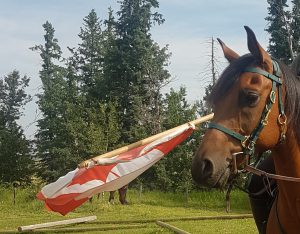
It’s very easy, intentionally or unintentionally, for us to cause stress in a horse. One of the most primary things to remember here is that the horse is an intelligent, thinking animal, just like you. He has fears and values, just like you. He has the ability to try and can feel success and pride, just like you. But unlike you he doesn’t have the ability to rationalize, make logical decisions nor perform comparative analysis of dissimilar objects or scenarios.
Sometimes we run into trouble with horses because we expect them to rationalize and use moral grounding like a human. In one of my Horsemanship Top Ten videos, I talked about how the horse’s brain works. Check it out. So, although we might not like what a horse is doing, it is IMPOSSIBLE for him to have a behaviour problem or to know better because that requires a moral basis for which to compare his actions – something he cannot do because of the limitations of his brain.
Instead, let’s focus on the reality of the situation; that the horse is reacting to pressures in his environment the way HORSES react to pressures in their environment. We’ve all had experiences with nervous horses, skittish horses, horses that kick, buck or even bite. Horses that are scared to move forward; horses that won’t slow down. Horses that want to be all over you and in your space; horses that don’t want to be anywhere near you. Horses that have trouble on one side vs the other – be that a lead change or a side-pass or even saddling or leading.
All the scenarios above stem from the same thing:
Horses respond to a pressure in the only way they know how to react.
And here is the one of the most important cornerstones of our horsemanship style:
We can show the horse an entirely different way of dealing with pressure, so that it no longer creates a stress and in fact, causes him to release tension and focus on us. This opens the door for the horse to be balanced and perform like an athlete.
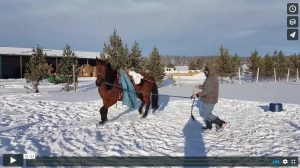 Here’s the proof: check out this video of a horse I worked with. “Johnny” was abused by a trainer to the point that he bucked, reared and struck and kicked at the sight of a saddle pad.
Here’s the proof: check out this video of a horse I worked with. “Johnny” was abused by a trainer to the point that he bucked, reared and struck and kicked at the sight of a saddle pad.
Where stress originates.
Stress in a horse’s environment can originate from pressures in three different categories:
- Herd pressure – This includes separation from companions and herd integration; for example, a new horse is introduced to the herd OR your horse does not know where he fits in the herd. The latter is a very common scenario in the horse’s relationship with humans.
- Predator pressure – As a prey animal, the horse’s first thought of the unknown is, “Is it going to eat us?” Their reaction to this stress is typically flee, freeze or in some cases, fight. What is important about Predator pressure is quite simple. Horses were born prey, and humans were born predators. The significant factor here is this: we can CHOOSE whether or not to act like a predator. We’ll choose to model a lead horse in our actions and feel.
- Physical pressure – Factors that relate to your horse’s body. These include being tired, thirsty, hungry or sore. Physical pressures also includes imbalance. If your horse is not balanced in his stance and movements this also causes muscular and mental tension.
Just like people, horses handle stress in ways unique to the individual. I see this in every clinic. One horse will walk up to an unknown obstacle and want to sniff it – or even grab it and shake it…and the next horse will be frozen in fear, snorting with wide eyes. The pressure is the same: the obstacle. However the stress it causes varies from horse to horse.
What is invariably the same across horses – and species for that matter – is that stress causes mental fatique, muscular tension, and a decreased ability to think clearly.
Take note…
There are different methods that you’ve probably heard of including desensitizing and bomb-proofing. An important thing to realize is that teaching a horse to stand still is NOT teaching him to handle pressure. Conversely, restraining a horse – with the lead rope or reins – while inducing
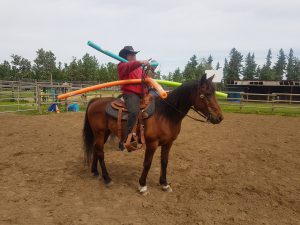
stress is a great way to teach him to rear, buck or learn to ignore.
Also, a horse that is not fleeing in fear is not necessarily accepting the pressure. The most likely scenario is that his level of stress is not yet at the point where he’s going to do something about it – and if your horse hasn’t been shown a different option, then his responses will be those of instinct. Horses that flee will take off, horses that freeze will buck or rear, and horses that fight will fight.
Stress is Cumulative
I had someone in a clinic recently ask me, “Why does my horse sometimes spook at a specific thing and sometimes not?” What we humans can relate to is that stress is cumulative. When the horse’s cumulative stress is more than he can handle, he’ll react in an obvious way. If it’s less than that, then you might feel him tense or simply see his attention shift.
Let’s say that we can measure pressures on a scale of 1-10, and consider this scenario. You have an important appointment in the morning in town. You get up to find your lane-way drifted over in 2 feet of snow (perhaps a 2/10 in pressure). So you go to get the tractor to plow out the lane-way, already knowing you’re going to be late. The tractor is in the shop…but you left your truck parked in front of the door. You go to start your truck, and…nothing. (3/10 in pressure, total stress: 5/10). You walk around the other side of the truck and see that your spouse unplugged your truck to plug in the car because you told her/him that you were taking the car into town – your fault. (2/10 in pressure, total stress: 7/10). As your line of sight follows the cord to the car, you see that the left front tire is flat. (4/10 in pressure). This is where folks ‘snap’ or ‘lose it’. UNLESS they have a way to deal with it.
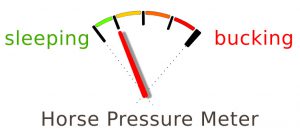
A horse is exactly the same. A horse that can hold it in can only do so until the cumulative stress exceeds what he can handle. You might not even be aware of all the individual pressures he is experiencing. A horse that is not moving under pressure might not be bomb-proof; he could very well be a ticking time bomb. I’ve seen this happen enough times to recognize it.
Training for Pressure
The path to success is to prevent pressure from producing undesired stress by showing the horse another way to deal with it. We do this primarily in two ways that we practice simultaneously.
- Stress causes muscular tension that is first manifested in the poll and neck. We can teach a horse to release those muscles when pressure is applied by connecting indirectly to those muscles through the lead rope or reins. Note: this does NOT mean pulling NOR does it mean a constant pressure – either of those will cause muscles to ENGAGE not RELEASE.
- The second and most important piece is mental stress. What caused that muscle to engage in the first place? You got it – his brain! Here’s the ticket: IF, and only IF the horse is following you as the leader, then he will follow your feel when he has a question about a pressure in his environment. The extent to which he will follow you depends on the amount of trust he has in you – read this article to find out about that. What we’re really doing when we apply a pressure to a horse is to say, “Feel like me.” And how should you feel? Confident. Relaxed. Positive. The horse will pick that up from you just as easily as he can sense your fear.
One of the first things we do at AHC with new clients or in clinics, after we’ve developed a leadership agreement with our horse, is to teach the horse what do do with higher levels of pressure, so that those pressures do not produce unwanted stress. In essence, we’re giving the horse a stress management tool to use instead of his instinctive flee, freeze or fight responses.
What we show horses is that pressure is a cue to release tension, focus and follow us. Can you start to think of how valuable this is in any environment? Here are just a couple examples that I’ve personally experienced:
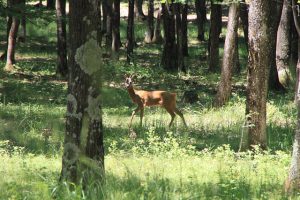 You’re on a trail ride and a deer jumps out on the trail – the other horses spook but your horse relaxes and waits for your guidance.
You’re on a trail ride and a deer jumps out on the trail – the other horses spook but your horse relaxes and waits for your guidance.
I was riding Ponkey on a trail with some folks at Yaha Tinda years ago. Something spooked the horse at the front, the rider got bucked off and it was a moment of mayhem. Ponkey did nothing, because I hadn’t asked him to do anything yet. We calmly walked over to a tree where I got off, tied him up and went to help the others.
A horse that pulls back learns that the way to relieve that tension in the rope is to relax.
My mare, Belle, got caught in a wire a couple of years ago. She didn’t struggle, but instead lay down and waited for help. If she would have pulled at all, she would have sliced right to the bone – it was a very fine wire.
How about saddling for the first time? Wouldn’t it be great to know your colt can handle the pressure of a saddle BEFORE you toss it up there? You can! It’s how we start horses here. You can see some of this in action in my videos with my wildie, Zeus.
There is so much value in teaching a horse how to handle pressure – instead of hoping that he can deal with it. I’m sure you can think of many examples from mounted shooting to competition stress to parades…essentially, anytime you’re with a horse.
Scott Phillips
March, 2018
